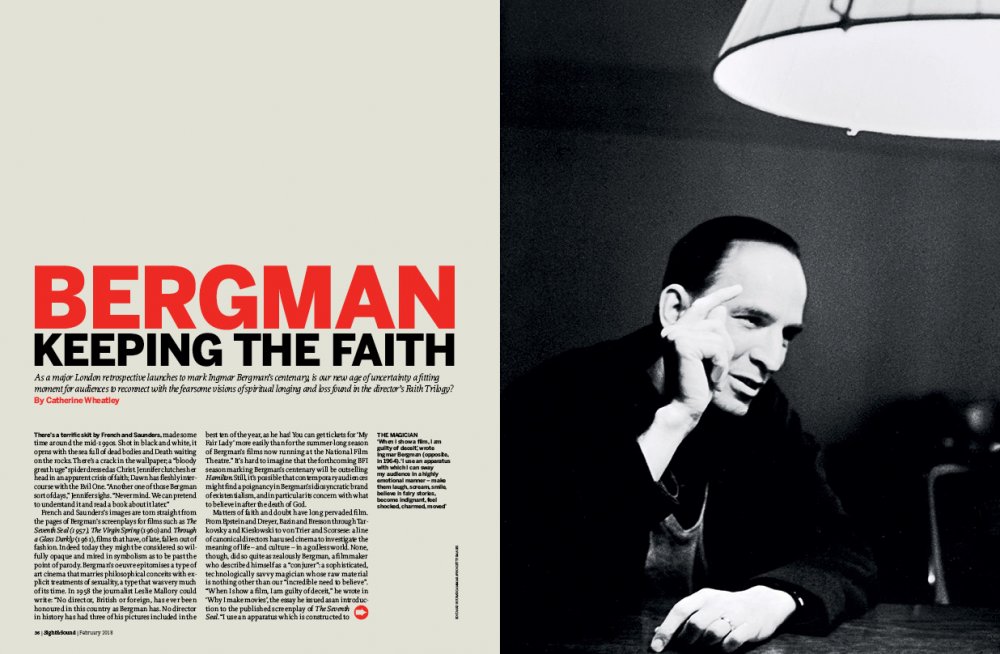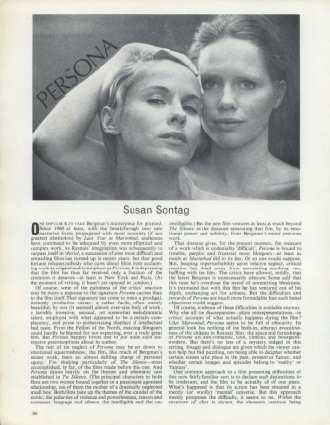Reactions to Persona have mostly ranged from incomprehension to irritation with what is dismissed as a characteristic piece of self-indulgence on Ingmar Bergman’s part – Bergman talking to himself again. Certainly Persona is Bergman’s most concentrated work, in a sense a summation of the themes dominant in most of his previous films; and it is undeniably a difficult film, if only because it leaves itself open to so many interpretations. But then so does Hamlet; and one suspects that negative reactions to Persona are more a response to Bergman than to the film itself. Bergman himself has already commented on the superficiality of such critical reactions in Now About These Women. That film was concerned with, amongst other things, the function and validity of art, its apparent impermanence and inadequacy.
Sweden 1967
Certificate 15 83 mins approx
Director Ingmar Bergman
Cast
Nurse Alma Bibi Andersson
Elisabet Vogler Liv Ullmann
doctor Margaretha Krook
Mr Vogler Gunnar Björnstrand
[boy] Jörgen Lindström
Original UK release date 21 September 1967
Alterative titles Masks; Diabolic Women
UK re-release date 1 January 2018
Distributor BFI
whatson.bfi.org.uk/Online/persona2018
► Trailer
Ingmar Bergman: a definitive season runs at BFI Southbank from January-March 2018.
The present film is, externally, a meditation on that theme – externally because Bergman specifically indicates in his opening sequence that what we are watching is a film, with all the conditions that this implies. On the screen we see two points of light, the arc lamps of a film projector; then a jumble of images: a film leader, some frames from a cartoon running through a projector, a nail being driven into a hand. In other words, we are reminded from the outset that what we see is a set of selected representations, capable of deceiving us – like the image of the nail and the hand, from which we recoil until we realise that it is faked. Similarly with the shot of the spider, which is a conscious reference back on Bergman’s part, but not a self-conscious one, since with it Bergman simply admits that this is his film.
We then see a boy, and in front of him a screen on which a blurred image gradually resolves itself into a woman’s face. The boy reaches up towards the face; and then the film proper begins, and we do not see the boy again until the very end of the film when, after a set of complementary images, the boy again reaches up to the face, and the film ends with the arc lamps again, their light fading into nothing. This apparently extraneous overture and coda to the film is surely the key to Bergman’s intention. It is a formal statement of the duality at the centre of the film, the duplication in the relationship between Elisabeth and Alma with its wider implications of the nature of our reaction to reality.

This theme of duplication, implicit in the film’s title with its dual meaning of mask and face, runs through the film on several levels; and in the space available here one can only indicate those levels. Elisabeth Vogler (Liv Ullmann), an actress, an artist (and so a charlatan, as her surname, the same as that of the magician in The Face, indicates), takes refuge from the ravages of the world behind a barrier of silence. We see her withdraw in terror from a television newsreel of the self-incineration of a Buddhist monk in Vietnam (it is significant that the commentary behind the newsreel is unrelated to the picture – one more indication of the duplicity of language); and from behind this barrier she watches the world, in the form of Alma (Bibi Andersson), reveal itself. The psychiatrist has explained Elisabeth’s breakdown as a realisation of the gulf between what she is as an artist and what she is in herself (her mask and her face), what she calls “the hopeless dread of being”. Suicide being a banal solution, Elisabeth opts for withdrawal from communication.
Bergman presents us with a deliberately neutral view of what happens between the two women – Alma’s identification with Elisabeth, her fantasies (or are they?) about Elisabeth coming into her room and the visit of Elisabeth’s husband. The point he is making is that this neutral viewpoint, like the mask of Elisabeth the actress and the face that Elisabeth shows to the world, is deceptive – not in fact a neutral view of something taking place but an artist’s selection of images, the mask of the artist himself. Bergman hints at this by repeating from the point of view of both women the scene in which Alma imagines that she has finally broken through to Elisabeth. The words spoken are the same, but the effect is very different. What Bergman is suggesting is that language, communication, and by extension art, is ultimately inadequate and fraudulent: there is always a mask to conceal the face. But Persona is not a pessimistic film. There is a point at which Elisabeth and Alma, mask and face, merge into one.
In the forthcoming February 2018 issue of Sight & Sound

Bergman: keeping the faith
As a major London retrospective launches to mark Ingmar Bergman’s centenary, is our new age of uncertainty a fitting moment for audiences to reconnect with the fearsome visions of spiritual longing and loss found in the director’s Faith Trilogy, asks Catherine Wheatley?

Read more in our digital archive
Susan Sontag’s seminal essay on Persona was published in the October 1967 issue of Sight & Sound. You can access that issue and all the historical issues of Sight & Sound and Monthly Film Bulletin in our digital archive.
☞
-
The Digital Edition and Archive quick link
Log in here to your digital edition and archive subscription, take a look at the packages on offer and buy a subscription.






